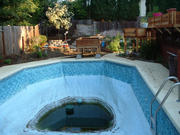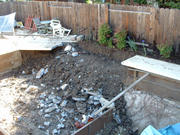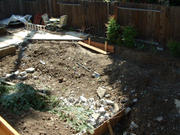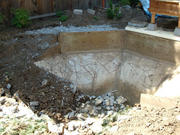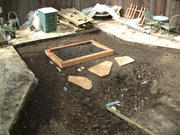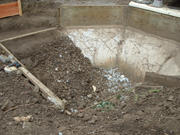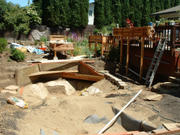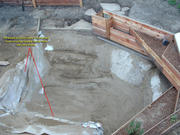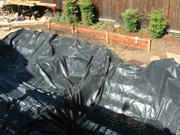Before you begin,
use this article to figure out your swimming pool volume, and
read this article to get an idea of what is going on and how big of an area around your pool that will need to be dug.
I will be showing how to remove a concrete and a liner pool in these instructions. The only difference between the two is a few of the steps will be different for each, but the overall idea is exactly the same for any type of swimming pool.
The photos posted here are from the removal of a liner pool. Keep in mind that I did my pool a little differently as I had no instructions or experience in doing this. These instructions are put together in such a way as to make it easier for the reader to understand the process. This is not an exact procedure, as every pool and every backyard will have slightly different needs. Although not exact, generally, the overall set of instructions should work for any pool removal.
DIY: HOW TO REMOVE A SWIMMING POOL
1. Drain your pool and remove your filter equipment and/or piping if necessary. You can drain your pool using your current pool pump by attaching a hose to the input of the pump and one at the output. Put the input into your pool and the output wherever you want the water to go. I used the water to irrigate my yard.
In most cases you can remove the old piping as you dig around the pool. So don't worry too much about that yet. You can just remove the pipes that are in the way when digging. Leave the remainder buried unless they will be in the way of future landscaping.
2. For concrete pools, cut out or knock out a couple large holes in the bottom of the pool. This will be for drainage and should be at least 3 feet wide. Fill the holes with rough fill sand, gravel, or drain rock. For liner pools, simply remove your liner.
(Optional) Add some stability to the area by setting rebar in a crossing and in a three dimensional pattern. Push the rebar in about 2 to 3 feet and tie the cross sections together with wire. Just use a simple pattern, or one that will suit the area. For concrete pools you will need to drill holes then put the rebar through the holes.
3. Build your pond frame where you want your pond to be. Refer to this link for
instructions on building a pond frame. Remember to keep the top of the pond about two feet below the current ground level(top of your pool). Make sure you support the new frame by setting posts in concrete like you would set fence posts, or by attaching posts to the concrete base of a concrete pool. This will give your pond walls strength when mounted to the posts. If you have a liner pool, you might want to wait until you remove the pool frame so you can reuse the wood for your pond frame.
Here you can kind of see the frame under the padding.
I only needed a partial frame, as I used the old pool bottom for the rest.
This photo was taken well into the process.
Unfortunately I have no photos of the actual frame construction.
4. If you have a concrete deck around your pool, break it up and toss it into the the pool. Put the concrete in the deepest areas of the pool. You want the concrete at least 2 feet from the top of your pond.
5. How you do the next step will be determined by your situation. In any of the situations, just throw the concrete or dirt into the pool.
For concrete pools:
- If you can easily break out the top two feet of concrete around your entire pool, then do so.
- If you can not easily break out the top two feet of concrete then dig a two foot deep by two feet wide trench around the pool. Then you should be able to break the top two feet of concrete out.
For liner pools:
- If you are not going to be using a current side of your pool as a side for your pond(or you are not going to have a pond) then remove the entire wooden frame around your pool.
- If you want to use part of the current frame as part of the pond frame, then only cut off the top two feet of that particular side. You may need to dig a 2 foot by 2 foot trench behind the frame to make that easier. Remove the rest of the frame without removing any structural support to the part you are leaving in. If that cannot be done you will have to add some new support with a 4x4 post and concrete(just like a fence post).
6. Dig out the surrounding area around your pool by removing the top two feet of soil surrounding your pool. Use the dirt to fill the pool. Make sure you pack the dirt down well as you fill the pool. This can be done easier by filling it part way then soaking the dirt with water. Keep repeating until you have completely filled your pool to the level you wanted(two feet below the old soil level)
The string line shows the old soil level.
7. Pack the area with a soil compactor or something equally effective. Make sure all the gaps are filled and there are no places where a collapse can occur. If there is such an area, you will find out during the first heavy rain storm you get. Unless the area was huge, it won't be a problem to just fill in with more soil or gravel at that time. I had two areas that created small holes in the top soil. One took about a half wheelbarrow to fill, the other just needed a few shovels full of dirt. The larger of the two was created because of the area between the temporary retaining wall(which I did not remove, I just buried it) and the new pond frame didn't get completely filled in.
What you see here was a temporary wall(left side) I used to keep the concrete
and dirt from filling the area until I knew I had enough dirt.
After I saw I had enough I began to bury the wall.
I built my frame late into the process.
Your pool is gone. Enjoy your new yard.
Landscaping my new backyard without a pool.





























